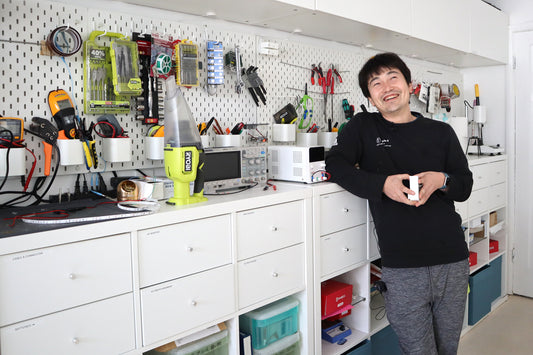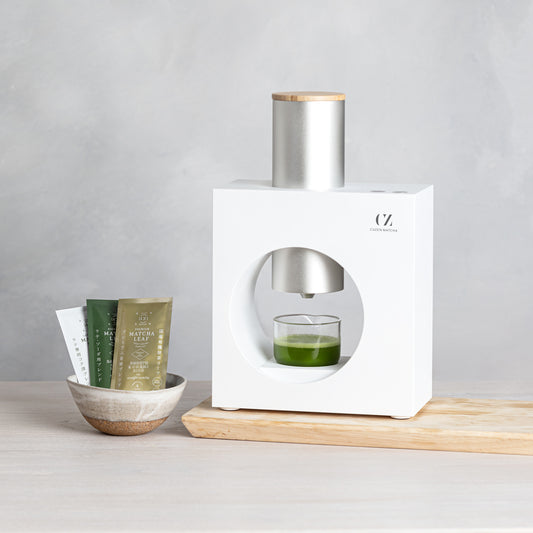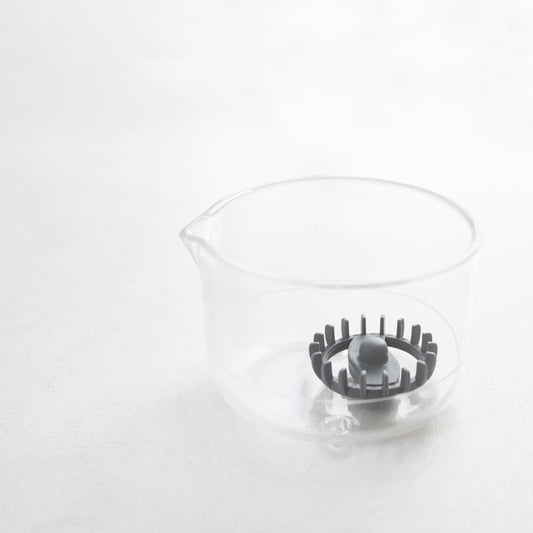

Talking with Japanese calligrapher, Aoi Yamaguchi
The artist collaborating on the launch of the Matcha Maker Sumi, was trained by calligraphy masters from childhood. Now she brings new movement to the tradition, including performance, music and a passion for the pine-soot smell of sumi.
Hometown: Hokkaido, Japan
Current residency: Venice, CA
Cuzen drink of choice: matcha latte
Contents
- An early introduction
- Drawing inspiration
- The rhythmic and colorful process
1. An early introduction
Aoi [A]: My name is Aoi Yamaguchi and I’m a Japanese calligrapher.
Cuzen [C]: What are your first memories of being introduced to calligraphy?
A: My mother took me to the Japanese calligraphy school in rural Hokkaido, where we used to live. That was my introduction to calligraphy. I still remember the smell of "sumi," or “ink.” It’s got this very distinctive aroma. I opened the door of the calligraphy school and was immediately surrounded by this smell. I remember that moment. I still love that smell. Sumi ink is the soot of burnt pine, and it’s pretty strong. It sticks to my clothing and fills the room. When I pour the sumi ink into the inkwell, I can really smell the fragrance, and it makes me straighten my back. I feel nostalgic and emotional about having learned under the masters, Zuiho Sato Sensei, “teacher,” and Kaho Sensei. They were amazing masters who taught about 30 or more children in a renovated room, in their home. I’m very grateful and thankful for what they taught me and what calligraphy itself really taught me about life. It’s all about patience and perseverance and the spirit of not giving up, until you are able to create this piece that you’re very proud of. Now I work on a piece dozens, hundreds and thousands of times until I feel like I nailed it.
C: What inspired you to pursue calligraphy?
A: There were two turning points in my life. I started to study calligraphy when I was six years old, and my senseis were very strict and wrote perfect, balanced characters. When I entered high school, I met another calligraphy teacher, who was a very free-spirited calligrapher. He would encourage students to bring and share poetry or song lyrics. That approach totally resonated with me because since I was little, I loved writing poetry and I love literature and music. I realized that calligraphy is not just about writing letters in a beautiful way, but can be self-expression. I started to write the words I liked, the quotes I liked and also words from my own poetry.
The second turning point came when I graduated from the university. I needed to decide about my career path, what I wanted to do with my life, and what it is that I can do that others can’t. At that time I remembered words from my teacher after I received the highest prize in a calligraphy competition, when I was 14. He told me, “Aoi san, this is telling you that you must continue practicing Japanese calligraphy.” So when I was trying to figure out what path I wanted to take, those words came to mind.
2. Drawing inspiration
C: What do you draw on for inspiration?
A: My inspiration comes from music, nature and poetry. I loved music growing up, and I have practiced piano since I was little. Whenever I listen to music, I get this vision of the ink and strokes moving in the air and dancing with the sound, and it's like a dance. Words just fall into my mind and that just becomes poetry. Then, I don’t want to forget, so I take my notebook and then write them down. I have many notebooks full of all these words and visions and imagery. So then I open a book and then think, “What do I want to write?”
I also collaborate with a lot of musicians for my work. I used to dance as well, so I think music and sound and the motion in the sound is in my body. When I'm writing, for example, stroke one goes, one, two, three, four. There's definitely a rhythm when I’m writing and I'm following the rhythm unique to that character. Then I just follow that energy and movement and that becomes the final work.
Nature is another big inspiration. I grew up in Hokkaido, the northernmost Japanese island, which is known for its natural beauty. I grew up in this environment with four distinctive seasons. The colors change, the temperature changes, and there are visual transitions throughout all four seasons. In the springtime, everything is coming back to life, and you see cherry blossoms everywhere. I feel excited and I want to compose a poem about it. It's very similar to composing a haiku or tanka, when you're inspired about seasons. The beauty in nature inspires me.
3. The rhythmic and colorful process
C: What was the process like for you to conceptualize and then actualize the design for Sumi?
A: I was asked to write “sumi iro," “color of sumi.” Sumi is the ink that I use for Japanese calligraphy. So when we say “sumi,” that is generally black. There are so many different hues or shades of black. In my work, I specialize in exploring those different hues. For example, "tanboku" is this "lighter gray hue of sumi ink" that the calligrapher creates by mixing different ratios of sumi ink, condensed sumi ink and water. I really enjoy exploring the different depths that can be created with sumi ink. I enjoyed figuring out what feels appropriate, what feels like the best match with the Sumi Matcha Maker. The color of the Maker is not quite pitch black or shiny black. It's a kind of matte charcoal, like darker gray. The relationship between the color of this black in my calligraphy and how that responded to the color of the Matcha Maker was very important for me. I wanted them to not fight each other or blend into each other, but co-exist in a really beautiful way together, to provide a nice contrast to each other. So, I looked up “sumi” and “iro” in the calligraphy dictionary, and started to explore different writing styles in order to see what felt right for this vision that I had.
Then I thought about the image of Cuzen. The Matcha Maker has these really clean geometric lines, and I wanted the calligraphy to contrast to the clean lines, to be a little bit more organic and flowy. I had this image of making a matcha latte—of the matcha dripping into the warm milk and the matcha swirling, you know, this movement, an organic flow. I started to sketch things out in my sketchbook, and I shared that with the team. Then I decided on the overall calligraphy design. After that, I explored with the sumi [ink]. Then I created a different hue of tanboku. I tried to write a couple different versions, seeing what felt best with the Sumi Matcha Maker. It was beautiful.
Related products
-
Organic Matcha Leaf packets
Regular price From $17.00USDRegular priceUnit price / per$17.00USDSale price From $17.00USD -
Matcha Maker Starter Kit
Regular price $299.00USDRegular priceUnit price / per -
Organic Single Origin Matcha Leaf
Regular price From $45.00USDRegular priceUnit price / per -
Whisking cup
Regular price $15.00USDRegular priceUnit price / per













